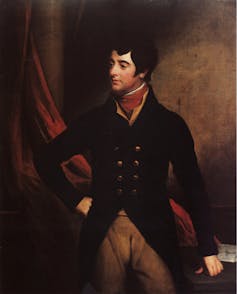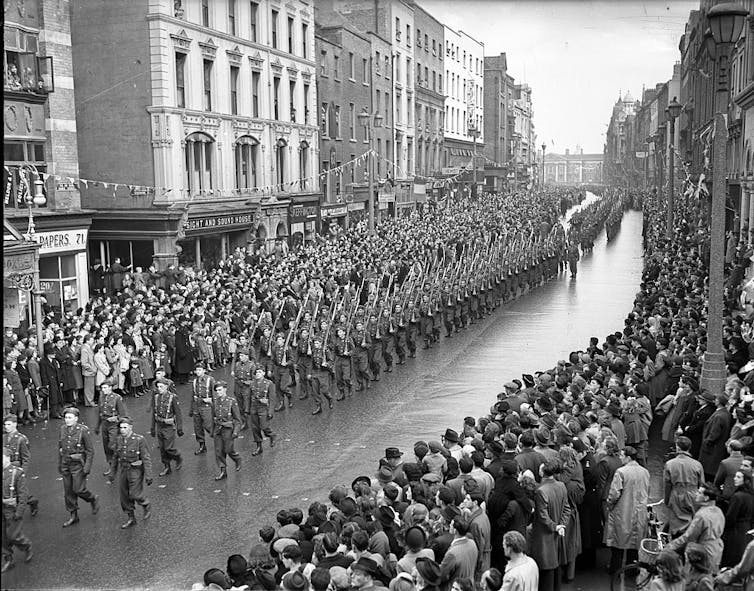(The Conversation) — Shortly before midnight on May 23, 1798, highwaymen just north of Dublin intercepted and set on fire a mail coach headed to Belfast.
It was the signal meant to ignite revolution across all Ireland.
At the time, Ireland was a kingdom within the state of Great Britain. The island’s three religious factions had long been divided. Families who belonged to the Anglican Church of Ireland made up the aristocratic landlords and colonial administrators. Presbyterians, concentrated in the north, boasted a robust middle class. But as “dissenters” from the Anglican church, they were second-class citizens.
And most of the remaining 80% of the population, the “native” Catholics, were near-destitute farmers. For more than a hundred years, they had lived under debilitating penal laws meant to keep Catholics out of economic and political power.

Portrait of Lord Edward Fitzgerald, painted by Hugh Douglas Hamilton.
Gallery of the Masters via Wikimedia Commons
A new organization, the Society of United Irishmen, was established in the early 1890s in Belfast, and chapters quickly spread to Dublin and across the country. Anyone could join, so long as they dreamed of making Ireland a republic, like the United States and France, where the people had dispensed with the monarch and ruled themselves.
Catholics and Presbyterians flocked to the cause, and even a few Anglicans joined up. The handsome and charismatic Lord Edward Fitzgerald, an Anglican son of a duke, renounced his title and commanded the society’s militia.
By 1798, a quarter of a million men, many armed with long-handled, iron-tipped pikes, awaited the summons.
It was the last time Catholics and Presbyterians in Ireland would unite under one banner in a really meaningful way until 1998, when a majority of both factions signed on to the Good Friday Agreement.
As an Irish studies scholar, I’d argue the nationalist movement was symbolized best by revolutionary Theobald Wolfe Tone, whose father was an Anglican tradesman and whose mother was born and raised a Catholic.
“I am a Protestant,” Tone wrote in his most famous political pamphlet, but also “a lover of justice and a steady detester of tyranny.”
Enlightenment ideals
Ever since King Henry VIII severed his nation’s ties to Roman Catholicism in the 16th century, Irish Catholics had suffered for their faith. Their lands were confiscated. They couldn’t bear arms. They couldn’t run schools or build churches. Though the worst of these laws had been reformed by the end of the 18th century and a small Catholic middle class was emerging, they were still barred from political office.
Inspired by the American and French revolutions, the United Irishmen wanted a secular republic that separated church from state. They professed the Enlightenment principles of equality, liberty and government by the people – and thought citizens had a duty to abolish any government destructive of their rights.
Their creed was a secular catechism, often expressed in the form of a question-and-answer text:
What is in your hand? It is a branch.
Of what? Of the Tree of Liberty
Where did it first grow? In America.
Where did it bloom? In France.
Where did the seeds fall? In Ireland.
Transcending sectarian differences, these Irish patriots took green as the color of their national flag. Upon this field they imposed an ancient symbol of Ireland, the harp.
The rebellion
The English began to suspect a revolt, and in 1787 they decided to strike first, unleashing a brutal crackdown. Redcoats “dragooned” the country, ransacking and burning homes, and flogging and summarily executing suspects.
The Irish still sing about it today in the ballad “The Wearing of the Green”:
I met with Napper Tandy and he took me by the hand,
He said, “How’s dear old Ireland and how does she stand?”
“She’s the most distressful country that you have ever seen,
They’re hanging men and women for the wearing of the green.”
Young Wolfe Tones singing ‘The Wearing of the Green.’
Most of the United Irishmen’s leaders, including Fitzgerald, were arrested or killed in the dragnet. As a result, when the signal finally came, the flaming mail coach proved a fizzle rather than a rocket.
Like guttering candles, the rebellion spent itself in uncoordinated risings at different times in different parts of the country. Help from France, which was then at war with Great Britain, came too little and too late. By October, Ireland’s revolution had been brutally suppressed.
Historical memory
Even before the conflict was over, aristocratic Anglican writers such as Sir Richard Musgrave spun the rebellion as an uprising of disgruntled Catholics. Reprisal killings, like rebels’ massacre of government supporters in County Wexford, helped them portray the rebellion as a religious war: Catholics against Protestants.
Cynical English policies further dissolved the Presbyterian-Catholic alliance. An “Act of Union” in 1800 rewarded Irish Presbyterians with full citizenship – not in an Irish republic, but in the Protestant, monarchical state of Great Britain.
Catholics, still oppressed and impoverished, had yet to face their most difficult trial: An Gorta Mor, the potato famine of the 1840s. About a million people, nearly all of them Catholic, died of starvation or disease, and another 2 million emigrated. Ireland’s population was reduced by a third.
Because Irish nationalism became synonymous with Catholic liberation, it was mostly Catholics who celebrated the memory of the United Irishmen. The “Fenians,” a nationalist brotherhood who fought for Irish independence in the 1860s, used the United Irishmen for inspiration. Their famous ballad “The Rising of the Moon” laments, “What glorious pride and sorrow/ Fill the name of Ninety-Eight!”

A memorial in County Wicklow to mark the 200th anniversary of the 1798 United Irishmen rebellion.
Hugh Rooney/Eye Ubiquitous/Universal Images Group via Getty Images
Religious states
On Easter Monday 1916, Irish republicans rose up again in Dublin, beginning the revolution that would lead, finally, to Irish independence. One portion of their forces, the Citizen Army, raised the old United Irishmen’s banner above their headquarters in Dublin, Liberty Hall.
But when the Irish got their “Free State,” they did not build the kind of secular republic envisioned by the United Irishmen. The new country was a decidedly Catholic nation.
The nation’s new flag, the Irish tricolor, included green for Catholics, orange for Protestants and white to represent peace between them. But it was a largely empty gesture. Today only about 4% of the population of the Republic of Ireland identify as Protestant, while another 15% say they have no religion.

A parade in Dublin in 1948 commemorates the 150th anniversary of the 1798 rebellion.
Independent News And Media/Hulton Archive via Getty Images
That’s mostly because in 1922 the British carved out an enclave of six northern counties where most of the Presbyterians and many Anglicans lived. This political entity, “Northern Ireland,” stayed united to England. Protestants outnumbered Catholics 2-to-1, and the minority faced widespread discrimination.
Inspired by Martin Luther King Jr., Catholics in Northern Ireland began a campaign for equal rights in 1968. But when their acts of civil disobedience were met with violence, peaceful protest devolved into “the Troubles,” a guerrilla war to get the British out.
Making peace
A ceasefire was called in 1994, not long before the bicentennial of Ireland’s 1798 rebellion.
To coincide with the anniversary, historian Kevin Whelan published an influential book, “The Tree of Liberty,” which emphasized the 1798 rebellion’s Enlightenment foundation. Catholics and Protestants together, Whelan argued, had fought to construct a secular nation based on equal rights.
In 1998, people all over the country commemorated the rebellion, though the sectarian divisions and the violence of the Troubles loomed large.
Almost exactly 200 years after the United Irishmen rose up, the people of Northern Ireland and the Republic of Ireland voted in favor of the Good Friday Agreement of 1998. Though Northern Ireland remains part of the United Kingdom today, the treaty secured the main goal of the 1798 rebellion: equal rights and self-determination for all citizens, no matter their religion.
(Joseph Patrick Kelly, Professor of Literature and Director of Irish and Irish American Studies, College of Charleston. The views expressed in this commentary do not necessarily reflect those of Religion News Service.)
![]()
Original Source: